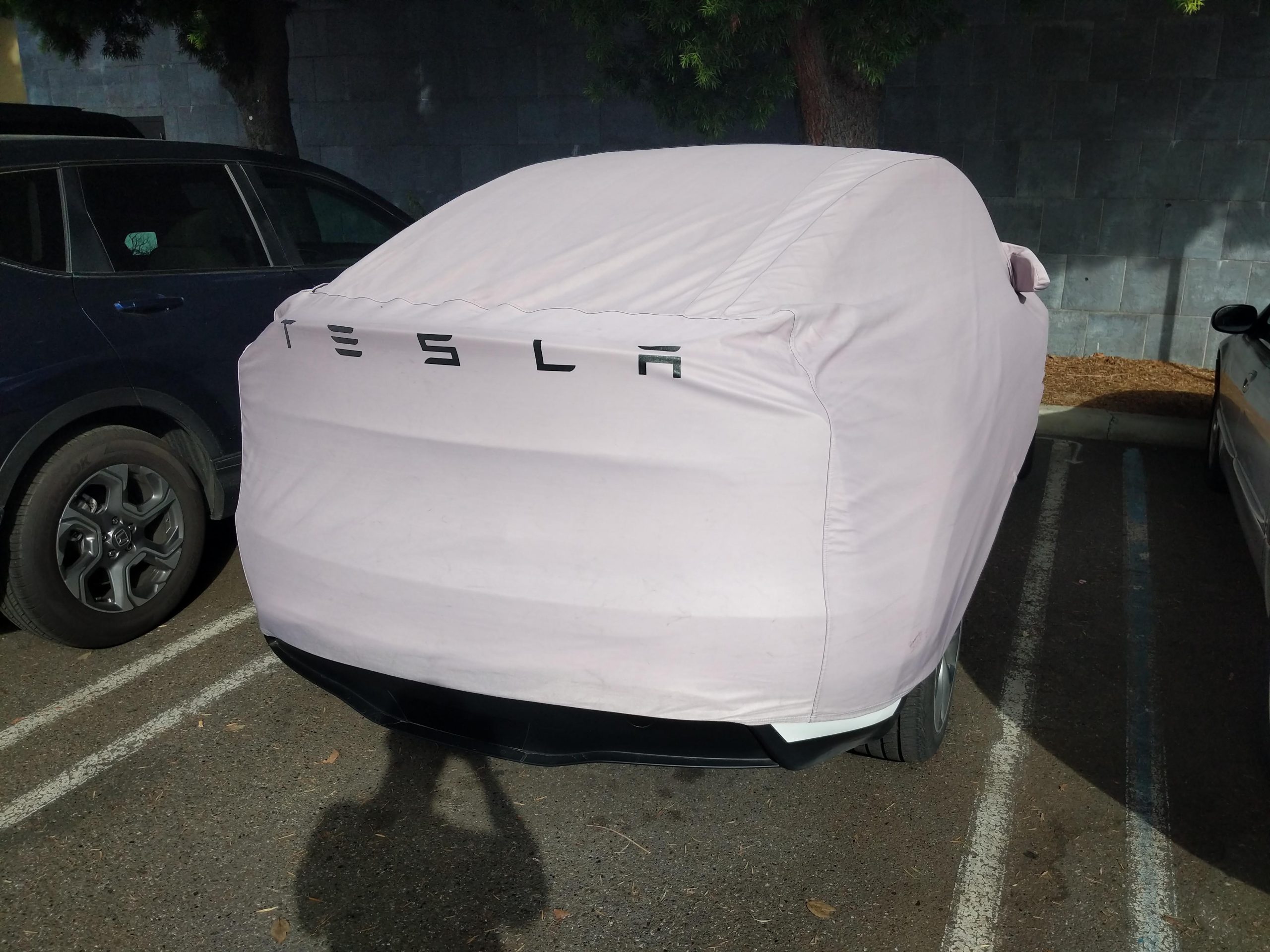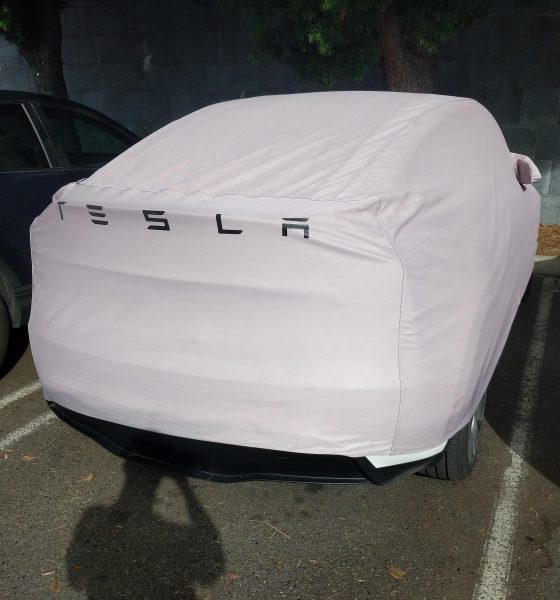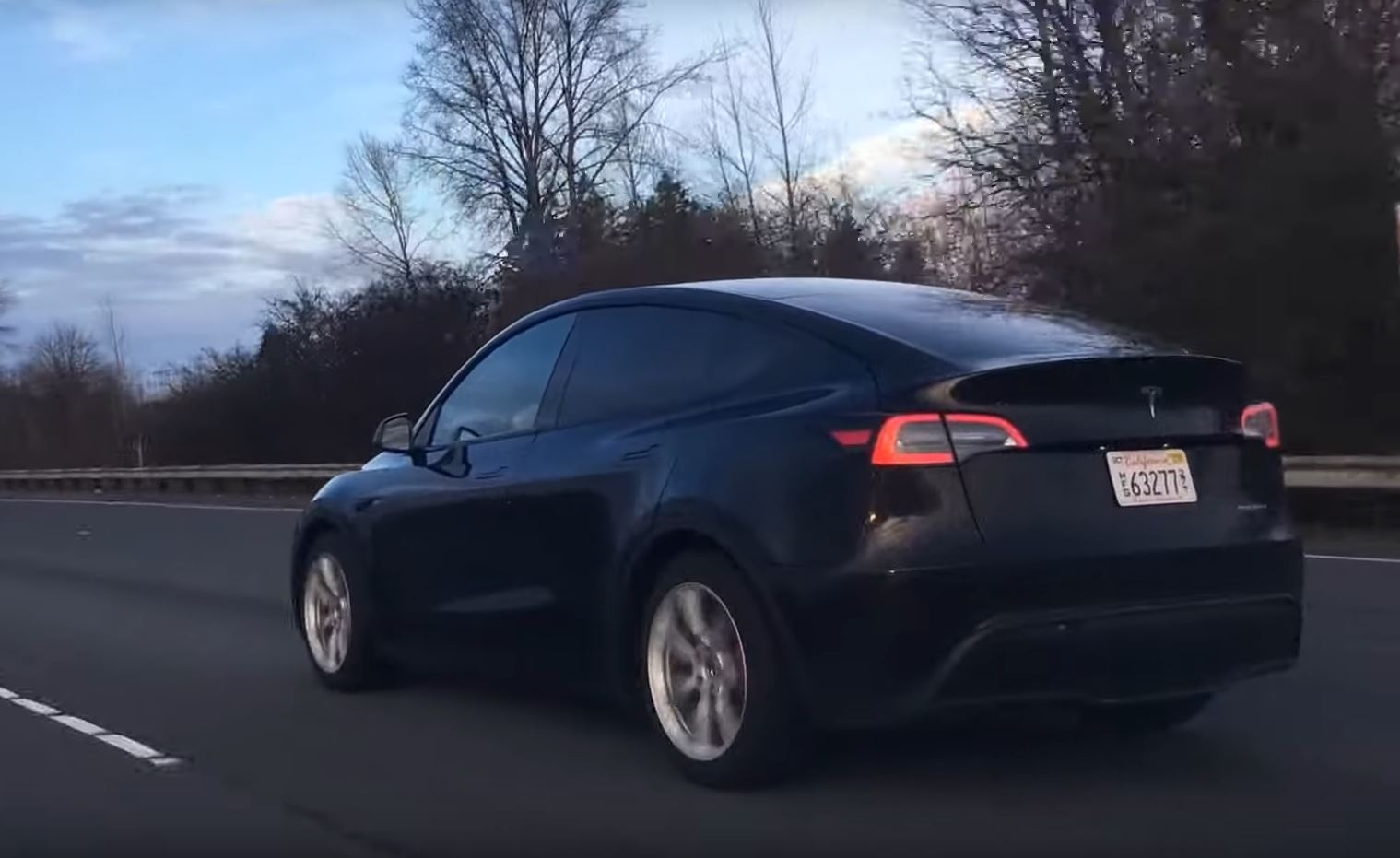

News
The Tesla Model Y is sized just right, and this will help it stand tall against rivals
Tesla’s much-awaited Model Y has piqued the curiosity of green car aficionados but it has always been described as the chunkier sibling of the Model 3 sedan or the smaller next of kin of the Model X SUV. Recently, another prototype of the electric crossover was spotted in California and while it was covered, someone measured the height of the Model Y. It’s 65 inches tall, placing it right in the middle of its rivals in the premium crossover segment.
Redditor u/gamerlike took the initiative to inform Tesla fans asking about the dimensions of the Tesla Model Y he saw in Mountain View. If his measurements are accurate, the Model Y will just be an inch shorter than the Model X, which stands 66 inches. Meanwhile, the Model 3 electric sedan’s height is pegged at 56.8 inches.
Recently, there have been more and more sightings of Tesla Model Y release candidates across the United States. A white Model Y Performance variant sporting a seemingly production-ready exterior was seen in San Luis Obispo, CA. There was also a black Model Y with red brake calipers that was spotted cruising along the I-5 in Washington State.
As the market awaits the Tesla Model Y release date, one cannot help but be more excited and compare the all-electric crossover to its possible competitors.
The Tesla Model Y electric crossover will be offered in three variants. The Rear-Wheel Drive Long Range version will sell for $48,000 while a Dual Motor All-Wheel Drive Long Range will go for $52,000. The Performance version, meanwhile, will set customers back by $61,000. The electric carmaker has moved the production up from Fall 2020 to Summer 2020, or if speculations from the community are any indication, maybe even sooner.
Tesla positions the Model Y luxury crossover against other premium vehicles in its class such as the BMW X3, Audi Q5, or the Jaguar I-PACE. Likewise, it can be compared to more affordable competitors in the segment such as the Honda CR-V and Toyota RAV4.
Tesla Model Y’s competitors are almost the same height. For example, the BMW X3 is 66 inches high while the Audi Q5 is 65 inches and the Jaguar I-PACE is a bit shorter at 61 inches. Meanwhile, the more affordable Honda CR-V stands at 66-67 inches and the RAV4 is a bit taller at 67-68 inches.

Price-wise, the Model Y is comparable to its premium rivals as well. The X3 will go for almost $42,000, the Audi Q5 will sell for around $43,000, and the Jaguar I-PACE will be at the higher end of the spectrum at almost $70,000. The Honda CR-V, meanwhile, will set back customers by $25,000 and the RAV4 will sell for around $26,000.
If the height of the vehicle will be a basis, we can fairly say that the Model Y will be comfortable with ample headroom and enough legroom just like other vehicles in its class. However, the Model Y might have an X-factor — it has a seven-seat option. The X3, Q5, I-PACE, and the more affordable CR-V and RAV4 do not.
The EV world is awaiting a glimpse of the Model Y interior and a test drive to determine if the Model Y’s extra seats at the back really work. Nevertheless, the presence of more seats can convince some customers that it’s the vehicle that fits their needs. Ask every mom or dad who has to deal with World War III when traveling with kids who are sharing the passenger seats. Extra seats mean world peace.
As of October 2019, crossovers consist 40.4% of light vehicle sales in the US followed by pickup trucks (17.6%) and small cars (11.6%) based on data compiled by Statista. The market has been shifting from sedans to compact SUVs for their good dose of comparable fuel efficiency with mid-sized cars and their higher seating positions.
One must take note that according to Tesla CEO Elon Musk, the Model Y will be sharing around 75% of the parts used for the Model 3. Expected demand for the Model Y is around 50 to 100% higher than the annual demand for the Model 3 as well. With the Model Y sharing the DNA of the Model 3, this might mean a more efficient production ramp.
Earlier this year, Forbes analyzed the potential of the Model Y for Tesla. Aside from the high demand stateside, one can only imagine how the Chinese and European markets would react to the electric crossover. In China, the Model 3 has created a loud buzz in the market, and it will likely serve as a catalyst to the country’s slumping automotive industry.
In Europe, the Gigafactory 4 in Brandenburg will play a crucial role in bringing Teslas to the region. Forbes predicts that Tesla will be able to deliver about 250,000 units of Model Y by 2022. According to the same analysis, the Model Y has the potential to bring in revenues amounting to $12 billion in the next 3 years.
While critics say the Tesla Model Y is just the chunkier version of the Model 3, it is clear that it has a ton of potential. It’s not a Cybertruck or a Roadster but it presents a good balance between form and function that really matters to car buyers, electric or otherwise.

News
Waymo sues Santa Monica over order to halt overnight charging sessions
In its complaint, Waymo argued that its self-driving cars’ operations do not constitute a public nuisance, and compliance with the city’s order would cause the company irreparable harm.

Waymo has filed a lawsuit against the City of Santa Monica in Los Angeles County Superior Court, seeking to block an order that requires the company to cease overnight charging at two facilities.
In its complaint, Waymo argued that its self-driving cars’ operations do not constitute a public nuisance, and compliance with the city’s order would cause the company irreparable harm.
Nuisance claims
As noted in a report from the Los Angeles Times, Waymo’s two charging sites at Euclid Street and Broadway have operated for about a year, supporting the company’s growing fleet with round-the-clock activity. Unfortunately, this has also resulted in residents in the area reportedly being unable to sleep due to incessant beeping from self-driving taxis that are moving in and out of the charging stations around the clock.
Frustrated residents have protested against the Waymos by blocking the vehicles’ paths, placing cones, and “stacking” cars to create backups. This has also resulted in multiple calls to the police.
Last month, the city issued an order to Waymo and its charging partner, Voltera, to cease overnight operations at the charging locations, stating that the self-driving vehicles’ activities at night were a public nuisance. A December 15 meeting yielded no agreement on mitigations like software rerouting. Waymo proposed changes, but the city reportedly insisted that nothing would satisfy the irate residents.
“We are disappointed that the City has chosen an adversarial path over a collaborative one. The City’s position has been to insist that no actions taken or proposed by Waymo would satisfy the complaining neighbors and therefore must be deemed insufficient,” a Waymo spokesperson stated.
Waymo pushes back
In its legal complaint, Waymo stated that its “activities at the Broadway Facilities do not constitute a public nuisance.” The company also noted that it “faces imminent and irreparable harm to its operations, employees, and customers” from the city’s order. The suit also stated that the city was fully aware that the Voltera charging sites would be operating around the clock to support Waymo’s self-driving taxis.
The company highlighted over one million trips in Santa Monica since launch, with more than 50,000 rides starting or ending there in November alone. Waymo also criticized the city for adopting a contentious strategy against businesses.
“The City of Santa Monica’s recent actions are inconsistent with its stated goal of attracting investment. At a time when the City faces a serious fiscal crisis, officials are choosing to obstruct properly permitted investment rather than fostering a ‘ready for business’ environment,” Waymo stated.
News
Tesla FSD v14.2.2 is getting rave reviews from drivers
So far, early testers have reported buttery-smooth drives with confident performance, even at night or on twisty roads.

Tesla Full Self-Driving (Supervised) v14.2.2 is receiving positive reviews from owners, with several drivers praising the build’s lack of hesitation during lane changes and its smoother decision-making, among others.
The update, which started rolling out on Monday, also adds features like dynamic arrival pin adjustment. So far, early testers have reported buttery-smooth drives with confident performance, even at night or on twisty roads.
Owners highlight major improvements
Longtime Tesla owner and FSD user @BLKMDL3 shared a detailed 10-hour impression of FSD v14.2.2, noting that the system exhibited “zero lane change hesitation” and “extremely refined” lane choices. He praised Mad Max mode’s performance, stellar parking in locations including ticket dispensers, and impressive canyon runs even in dark conditions.
Fellow FSD user Dan Burkland reported an hour of FSD v14.2.2’s nighttime driving with “zero hesitations” and “buttery smooth” confidence reminiscent of Robotaxi rides in areas such as Austin, Texas. Veteran FSD user Whole Mars Catalog also demonstrated voice navigation via Grok, while Tesla owner Devin Olsen completed a nearly two-hour drive with FSD v14.2.2 in heavy traffic and rain with strong performance.
Closer to unsupervised
FSD has been receiving rave reviews, even from Tesla’s competitors. Xpeng CEO He Xiaopeng, for one, offered fresh praise for FSD v14.2 after visiting Silicon Valley. Following extended test drives of Tesla vehicles running the latest FSD software, He stated that the system has made major strides, reinforcing his view that Tesla’s approach to autonomy is indeed the proper path towards autonomy.
According to He, Tesla’s FSD has evolved from a smooth Level 2 advanced driver assistance system into what he described as a “near-Level 4” experience in terms of capabilities. While acknowledging that areas of improvement are still present, the Xpeng CEO stated that FSD’s current iteration significantly surpasses last year’s capabilities. He also reiterated his belief that Tesla’s strategy of using the same autonomous software and hardware architecture across private vehicles and robotaxis is the right long-term approach, as it would allow users to bypass intermediate autonomy stages and move closer to Level 4 functionality.
News
Elon Musk’s Grok AI to be used in U.S. War Department’s bespoke AI platform
The partnership aims to provide advanced capabilities to 3 million military and civilian personnel.

The U.S. Department of War announced Monday an agreement with Elon Musk’s xAI to embed the company’s frontier artificial intelligence systems, powered by the Grok family of models, into the department’s bespoke AI platform GenAI.mil.
The partnership aims to provide advanced capabilities to 3 million military and civilian personnel, with initial deployment targeted for early 2026 at Impact Level 5 (IL5) for secure handling of Controlled Unclassified Information.
xAI Integration
As noted by the War Department’s press release, GenAI.mil, its bespoke AI platform, will gain xAI for the Government’s suite of tools, which enable real-time global insights from the X platform for “decisive information advantage.” The rollout builds on xAI’s July launch of products for U.S. government customers, including federal, state, local, and national security use cases.
“Targeted for initial deployment in early 2026, this integration will allow all military and civilian personnel to use xAI’s capabilities at Impact Level 5 (IL5), enabling the secure handling of Controlled Unclassified Information (CUI) in daily workflows. Users will also gain access to real‑time global insights from the X platform, providing War Department personnel with a decisive information advantage,” the Department of War wrote in a press release.
Strategic advantages
The deal marks another step in the Department of War’s efforts to use cutting-edge AI in its operations. xAI, for its part, highlighted that its tools can support administrative tasks at the federal, state and local levels, as well as “critical mission use cases” at the front line of military operations.
“The War Department will continue scaling an AI ecosystem built for speed, security, and decision superiority. Newly IL5-certified capabilities will empower every aspect of the Department’s workforce, turning AI into a daily operational asset. This announcement marks another milestone in America’s AI revolution, and the War Department is driving that momentum forward,” the War Department noted.








